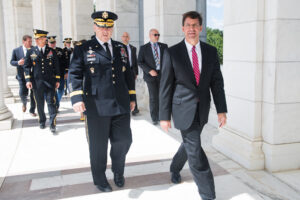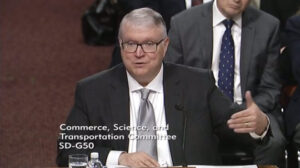 WASHINGTON: The Defense and Commerce department are in talks over whether to relax rules for commercial remote sensing satellites that could be kicked upstairs to Secretaries Mark Esper and Wilbur Ross over the next few weeks, insiders say.
WASHINGTON: The Defense and Commerce department are in talks over whether to relax rules for commercial remote sensing satellites that could be kicked upstairs to Secretaries Mark Esper and Wilbur Ross over the next few weeks, insiders say.
The Commerce Department wants to relax the rules. Some in the Pentagon don’t. The two sides are scheduled to meet tomorrow at the policy level to informally discuss post-comment period revisions to the Commerce Department rule-making originally issued in May, and hopefully smooth out remaining — or new — areas of friction. But, if a mutual understanding cannot be reached, a series of meetings up the chain of command will take place over the next couple weeks — perhaps all the way to the principals level.
Complicating the discussions, insiders say, is that there continues to be disagreement within the DoD about any relaxation of restrictions on commercial sales of remote sensing data.

DoD Secretary Mark Esper, right
“It’s mostly a bunch of backward-looking colonels at DoD” that are worried about potential negative impacts on national security of allowing more US commercial data into the market, said one industry source — rather than, as one would naturally suspect, officials at the National Reconnaissance Office.
Indeed, industry and government insiders say, a number of DoD policy-makers are sympathetic to industry’s argument that the remote sensing cat is already all the way out of the bag — with countries from Russia and China to India and South Korea already home to companies putting high resolution, low latency and persistent imagery on the market. For this reason alone, Esper may need to wade into the fray.
A Commerce spokesman did not respond to a request for comment by publication; DoD Public Affairs demurred.
In particular, some at DoD have been extremely leery of any roll back of restrictions on companies wishing to sell imagery of spacecraft on orbit, and from Synthetic Aperture Radar (SAR) satellites that can ‘see’ at night and through fog. (Breaking D readers may recall that the US Intelligence Community has long had an ‘It’s Complicated’ relationship status with would-be commercial providers of SAR and other geospatial imagery.)
Indeed, the Defense Intelligence Agency (DIA) has long been concerned about the proliferation of SAR capabilities. The DIA cited China’s development of SAR satellites, and jammers for such satellites, as a threat to US national security space assets in its January report, “Challenges to Security in Space.” It also considers developing Chinese and Russian capabilities to monitor satellites in space, commonly known as Space Situational Awareness (SSA), to be part of their counterspace capabilities.
Meanwhile, the Commerce Department already has sent its revised draft rule-making to ease licensing of commercial remote sensing operators to the White House Office of Management and Budget (OMB) for review and formal interagency coordination.
“I am delighted to report that the Department’s rule on commercial remote sensing has been sent to OMB for interagency consideration,” Kevin O’Connell, director of Commerce’s Office of Space Commerce, told the audience at the US Chamber of Commerce’s launch seminar on Tuesday.
OMB must decide whether the changes made from the original notice of public rule-making (NPRM) issued by the National Oceanic and Atmospheric Administration on May 14 are significant enough to warrant another round of public comment. NOAA, which falls under the purview of Commerce, currently is in charge of licensing commercial remote sensing. OMB also must broker the formal interagency review process, which the referral sets in train.
The revision of the commercial remote sensing rules was mandated by the White House in Space Policy Directive-2 (SPD-2), as part of the Trump Administration’s wider effort to cut red tape and promote commercial space industry innovation. To that end the new rules will operate with a presumption of approval, in contrast to the current process, which requires specific DoD and State Department approval for each license. In essence, the new rules would create a form of ‘generic’ license for most remote sensing activities, while applying a more robust process for those found to be of potential national security concern.
Under the original May 14 draft NPRM, the rules regarding sharing data from SAR and SSA operations would have remained more or less the same — in large part due to DoD pressure.
The May draft would have kept strict limits on commercial use of synthetic aperture radar (SAR) data, including limiting resolution to 0.25 meters, and banning any transmission of SAR data to receivers outside the US. It further would have restricted satellite imaging of other spacecraft unless written permission is obtained, including limiting resolution to above 0.5 meters. Providing imagery of objects not included in the US military’s space object catalog and published in space-track.org would continue to be outlawed.
However, a number of commercial remote sensing satellites — including major players Maxar, Planet, HawkEye 360, BlackSky Global and Spire Global — formally objected to the proposed rules, arguing they would hobble international sales. Indeed, as colleague Caleb Henry first reported back in June, the Advisory Committee on Commercial Remote Sensing (ACCRES) representing the remote sensing industry was highly critical of the proposed rules at its June meeting. The industry comment period closed at the end of June; Commerce has been working on revisions ever since.
While industry sources say they remain a bit nervous, all indications are that Commerce took industry concerns seriously and made serious efforts to take them into account — which seems to be prompting even more distress from some quarters at DoD.
At the Aug. 21 meeting of the National Space Council, Commerce Secretary Wilbur Ross acknowledged industry concerns and vowed to issue new regulations “that encourage domestic innovation while ensuring the global competitiveness and market leadership of American companies.” (At that time, Ross said he expected the new rules to be finalized in October — something that obviously didn’t happen.)
“In re-crafting the rule, NOAA took into account many, many industry comments,” O’Connell said yesterday. “The rule recognizes the speed at which many new technologies are entering the market, including overseas. It also recognizes the ever-changing business models and where value is created in the volumes of diverse imagery data being sent back to Earth.”
O’Connell stressed that the space economy is “one of highest priorities of the Department of Commerce, and top priority of the administration.”

Kevin O’Connell
“The space economy continues to grow,” he added. “In July, the Space Foundation reported that the global space economy grew to $415 billion, exceeding $400 billion for very first time. Our major financial institutions projected the global space industry to be worth $1.3 trillion by 2040.”
O’Connell explained that “part of that value will come from improving or creating new services to enhance our lives on earth, while another part will come from the establishment of a cislunar economy.”
The Commerce Department has been a champion for new types of satellite operations, such as satellite servicing and re-fueling, as well as longer term potential commercial capabilities such as asteroid mining and lunar water extraction. DoD and the Air Force, too, have been intrigued by the potential for leveraging commercially developed maneuverable satellites and the possibilities for utilizing the orbital region beyond Earth’s gravity out to the Moon for future military space operations.
Air Force picks Anduril, General Atomics for next round of CCA work
The two vendors emerged successful from an original pool of five and are expected to carry their drone designs through a prototyping phase that will build and test aircraft.


























